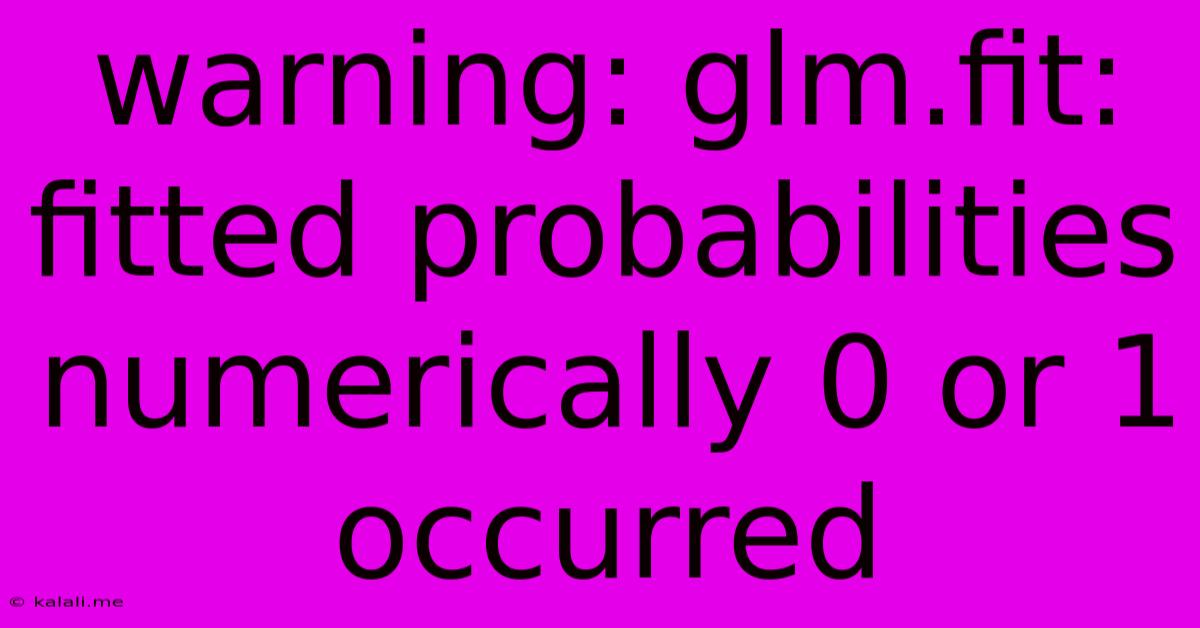Warning: Glm.fit: Fitted Probabilities Numerically 0 Or 1 Occurred
Kalali
Jun 04, 2025 · 3 min read

Table of Contents
Warning: glm.fit: Fitted Probabilities Numerically 0 or 1 Occurred: Understanding and Addressing the Issue in R
This common warning in R, "glm.fit: fitted probabilities numerically 0 or 1 occurred," often arises when working with generalized linear models (GLMs), particularly logistic regression. It signifies a problem with your model's fit and can lead to inaccurate predictions and unreliable inferences. This article delves into the causes of this warning, its implications, and strategies for resolving it. Understanding this will improve the accuracy and reliability of your statistical modeling.
What Does the Warning Mean?
The warning indicates that your model has predicted probabilities of an event occurring that are extremely close to 0 or 1. These are numerically indistinguishable from 0 or 1 within the computational limits of the software. This situation is problematic because several statistical calculations, such as computing log-likelihoods or standard errors, are undefined or highly unstable when probabilities reach these extremes. This ultimately affects your model's performance and interpretation. Essentially, your model is overconfident in its predictions for certain data points.
Causes of the Warning
Several factors contribute to this warning message:
-
Complete Separation: This is the most frequent cause. Complete separation occurs when a predictor variable perfectly predicts the outcome. For example, in logistic regression, if all individuals with a certain value of a predictor variable belong to one outcome group, and all individuals with another value belong to the other outcome group, perfect separation exists. The model tries to assign probabilities of 0 or 1 to reflect this perfect prediction, leading to the warning.
-
Quasi-Complete Separation: This is similar to complete separation but less extreme. A near-perfect prediction occurs, where almost all observations with a specific predictor value belong to a single outcome group. The model again struggles to estimate parameters accurately, resulting in extreme probabilities.
-
Small Sample Size: With limited data points, particularly in cases of imbalanced classes (where one outcome group has significantly fewer observations than the other), the model might overfit to the available data, producing extreme probability estimates.
-
High Multicollinearity: If predictor variables are highly correlated, it can lead to instability in the model's estimation process and extreme probability predictions.
Implications of the Warning
Ignoring this warning can have serious consequences:
-
Inaccurate Confidence Intervals and p-values: The standard errors of the coefficients become unreliable, leading to potentially misleading confidence intervals and p-values. This impacts the interpretation of statistical significance.
-
Biased Parameter Estimates: Extreme probabilities can bias the estimates of model coefficients, distorting the relationship between predictors and the outcome.
-
Unreliable Predictions: Predictions generated from a model exhibiting this warning may be inaccurate and overly confident.
Addressing the Warning
Several approaches can mitigate this issue:
-
Regularization Techniques: Techniques like ridge regression or LASSO can shrink the coefficients towards zero, reducing the influence of individual predictors and preventing extreme probability estimates. These methods are particularly helpful when dealing with high multicollinearity or overfitting.
-
Feature Selection/Engineering: Carefully examine your predictor variables. Removing redundant or irrelevant predictors can improve model stability. Creating interaction terms or transforming variables can also address the issue.
-
Data Augmentation (for small sample sizes): If your sample size is small, consider augmenting your dataset with synthetic data points generated using techniques like SMOTE (Synthetic Minority Over-sampling Technique).
-
Consider a Different Model: In some cases, a different model might be more appropriate. For instance, a more flexible model might better capture the relationships in your data without leading to extreme probabilities.
-
Penalized Logistic Regression: This approach incorporates a penalty term into the likelihood function to shrink the coefficients, thus preventing extreme probability estimates.
Conclusion
The "glm.fit: fitted probabilities numerically 0 or 1 occurred" warning in R is a significant indicator of potential problems with your GLM. By understanding the underlying causes and employing the appropriate strategies, you can improve the reliability, accuracy, and interpretability of your statistical models. Remember to carefully examine your data, choose appropriate modeling techniques, and always interpret results cautiously.
Latest Posts
Latest Posts
-
What Does It Mean To Hot Shot To The Top
Jun 06, 2025
-
When Is It Best To Check Your Oil
Jun 06, 2025
-
Is Fire One Or Two Syllables
Jun 06, 2025
-
Is It Haram To Shave Your Beard
Jun 06, 2025
-
Sun Dried Stucco Color On Walls
Jun 06, 2025
Related Post
Thank you for visiting our website which covers about Warning: Glm.fit: Fitted Probabilities Numerically 0 Or 1 Occurred . We hope the information provided has been useful to you. Feel free to contact us if you have any questions or need further assistance. See you next time and don't miss to bookmark.